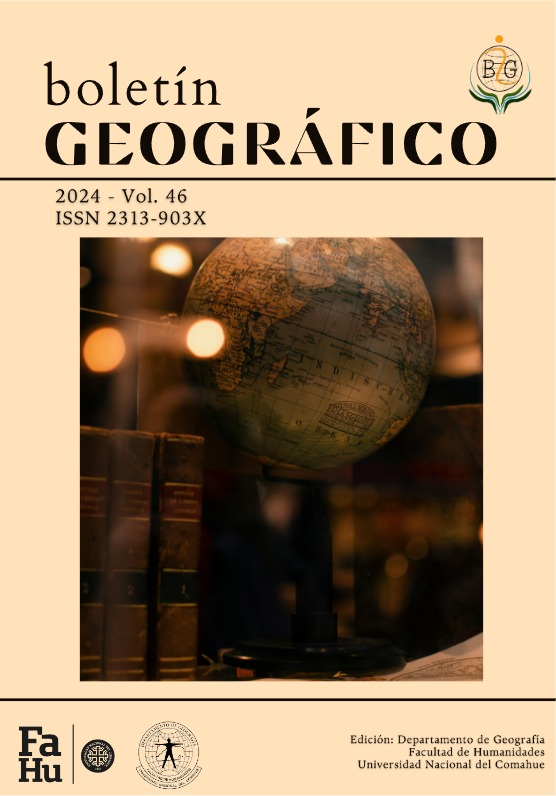Identification of flood-prone areas in San Cayetano provincial park (Corrientes, Argentina)
Keywords:
risk mapping, floods, digital elevation models, droneAbstract
The town of San Cayetano and particularly the Provincial Park with the same name, presents recurring cases of flooding in wet periods, mainly after intense rainfall given the almost immediate response of the river flow to inclement weather due to its very small basin. The main objective of the work is to generate a Digital Elevation Model of high spatial resolution and vertical precision of the Park from a drone flight and the use of Geographic Information Technologies. To achieve this objective, measurements of Photogrammetric Support Points (PAF) were first carried out with a South Galaxy G1 geodesic receptor GNSS, which will provide greater reliability to the results generated in the post-processing stage, and San Cayetano Park was flown over with a Mavic 2 pro model drone. from the DJI firm, which has a 1” CMOS sensor and 20 megapixel resolution, which made it possible to obtain aerial photographs with the characteristics necessary for the generation of an DEM. Subsequently, with the use of specific software, these photographs were processed, and a high spatial resolution DEM was generated. From this product, and with the help of Geographic Information Systems, maps were generated that show different possible threat scenarios at certain flood levels based on the advance of water over the study area and in this way contribute to the management and early warning of these events.
Downloads
References
Bates, P. D., & De Roo, A. P. J. (2000). A Simple Raster-Based Model for Flood Inundation Simulation. Journal of Hydrology, 236(1-2), 54-77.
Contreras, F. I. y Contreras, S. A. (2017). La Incidencia de la Pendiente en la Distribución de las Morfologías de las Lagunas sobre Lomadas Arenosas (Corrientes, Argentina). Anuário do Instituto de Geociencias – UFRJ. 40 (1), 15-25.
Contreras, F. I. y Odriozola, M. P. (2016). Aplicación de Modelos de Elevación Digital para la delimitación de áreas de riesgo por inundaciones. San Luis del Palmar, Corrientes, Rca. Argentina. Contribuciones Científicas GAEA. 28, 83-94.
Contreras, F. I., Saucedo, G. I. y Smichowski, H. (2022). Análisis de la frecuencia de inundaciones en el Parque Provincial San Cayetano (Corrientes, Argentina). ScientiAmericana. Vol. 9, N°1, 35-46. http://dx.doi.org/10.30545/scientiamericana
Felder, G., & Wechsler, S. (2007). The use of DEMs in flood modeling: Comparison of LiDAR and SRTM derived elevation data. Photogrammetric Engineering & Remote Sensing, 73(2), 163-169.
Garnica Peña, R. J., y Alcántara Ayala, I. (2004). Riesgos por inundación asociados a eventos de precipitación extraordinaria en el curso bajo del río Tecolutla, Veracruz. Investigaciones geográficas, (55), 23-45.
McCreary, A., Seekamp, E., Larson, L. R., Smith, J., & Davenport, M. A. (2024). Climate change and nature-based tourism: How do different types of visitors respond? Tourism Planning & Development, 21(1), 1-19.
Mejía-Coca, M. E., Ruilova-Cueva, M. B. y Mendiburu-Rojas, F. A. (2023). Plan de gestión de riesgos y su impacto en la prevención de desastres naturales en el cantón Montalvo. Journal of Science and Research, 8(3), 176-191. http://dx.doi.org/10.5281/zenodo.8148505
Merwade, V., Cook, A., & Coonrod, J. (2008). GIS Techniques for Creating River Terrain Models for Hydrodynamic Modeling and Flood Inundation Mapping. Environmental Modelling & Software, 23(10-11), 1300-1311.
Meza, J. C. (2020). Análisis comparativo de los modelos digitales de elevaciones SRTM y MDE-Ar 2.0 para la identificación de áreas de peligrosidad por inundaciones y anegamientos en un área urbana de llanura. Geográfica Digital, 17(33), 44–60. https://doi.org/10.30972/geo.17334015
Objetivos del Desarrollo Sostenible. Recuperado de: https://www.un.org/sustainabledevelopment/es/objetivos-de-desarrollo-sostenible/ (12/4/2024)
Perry, E.E., Xiao, X., Nettles & J.M. (2021). Park Visitors’ Place Attachment and Climate Change-related Displacement: Potential Shifts in Who, Where, and When. Environmental Management, 68, 73–86. https://doi.org/10.1007/s00267-021-01480-z
Popolizio, E. 1989. Algunos elementos geomorfológicos condicionantes de la organización espacial y las actividades del NEA. Geociencias, 17, 3-12.
Portilla, O., Leiva, C., Luna, M., y González, I. (2023). Evaluación de los modelos digitales de terreno y geopotenciales en el Ecuador. LA GRANJA. Revista de Ciencias de la Vida, 38(2), 59-81.
Ramallo, E. D., y Ostapoff, A. J. (2023). La obtención de información topográfica de un terreno en base a datos de libre acceso y software de código abierto. tecYt, (9), 16-22.
Reiter, K., Knittel, N., Bachner G., & Hochrainer-Stigler, S. (2022). Barriers and Ways Forward to Climate Risk Management against Indirect Effects of Natural Disasters: A Case Study on Flood Risk in Austria. Climate Risk Management. 36:100431. https://doi.org/10.1016/j.crm.2022.100431
Werner, M. G. F., Hunter, N. M., & Bates, P. D. (2005). Identifiability of distributed floodplain roughness values in flood extent estimation. Journal of Hydrology, 314(1-4), 139-157.
Wood, P. J., & Armitage, P. D. (1997). Biological Effects of Fine Sediment in the Lotic Environment. Environmental Management, 21(2), 203-217.
Yamazaki, D., O'Loughlin, F., Trigg, M. A., Miller, Z. F., Pavelsky, T. M., & Bates, P. D. (2014). Development of the global width database for large rivers. Water Resources Research, 50(5), 3467-3480.
Published
How to Cite
Issue
Section
ARK
License
Copyright (c) 2024 Boletín GeográficoTransfer of rights and data processing
The acceptance of an article for publication in the Journal Geographic Bulletin implies the cession of the rights of printing and reproduction, by any means and means, of the author in favor of the Department of Geography of the National University of Comahue, which will not reject any request reasonable for the authors to obtain permission to reproduce their contributions. The total or partial reproduction of the works published in the Geographic Bulletin must be done citing the origin, otherwise, the copyright is violated.
Likewise, it is understood that the concepts and opinions expressed in each work are the sole responsibility of the author, without being responsible or in solidarity, necessarily, neither the editorial staff nor the editorial staff.
It is the responsibility of the authors to be able to provide interested readers with copies of the raw data, procedure manuals, scores and, in general, relevant experimental material.
Likewise, the Management of the journal guarantees the appropriate treatment of personal data
COPYRIGHT TRANSFER FORM


















 Journal of the
Journal of the 